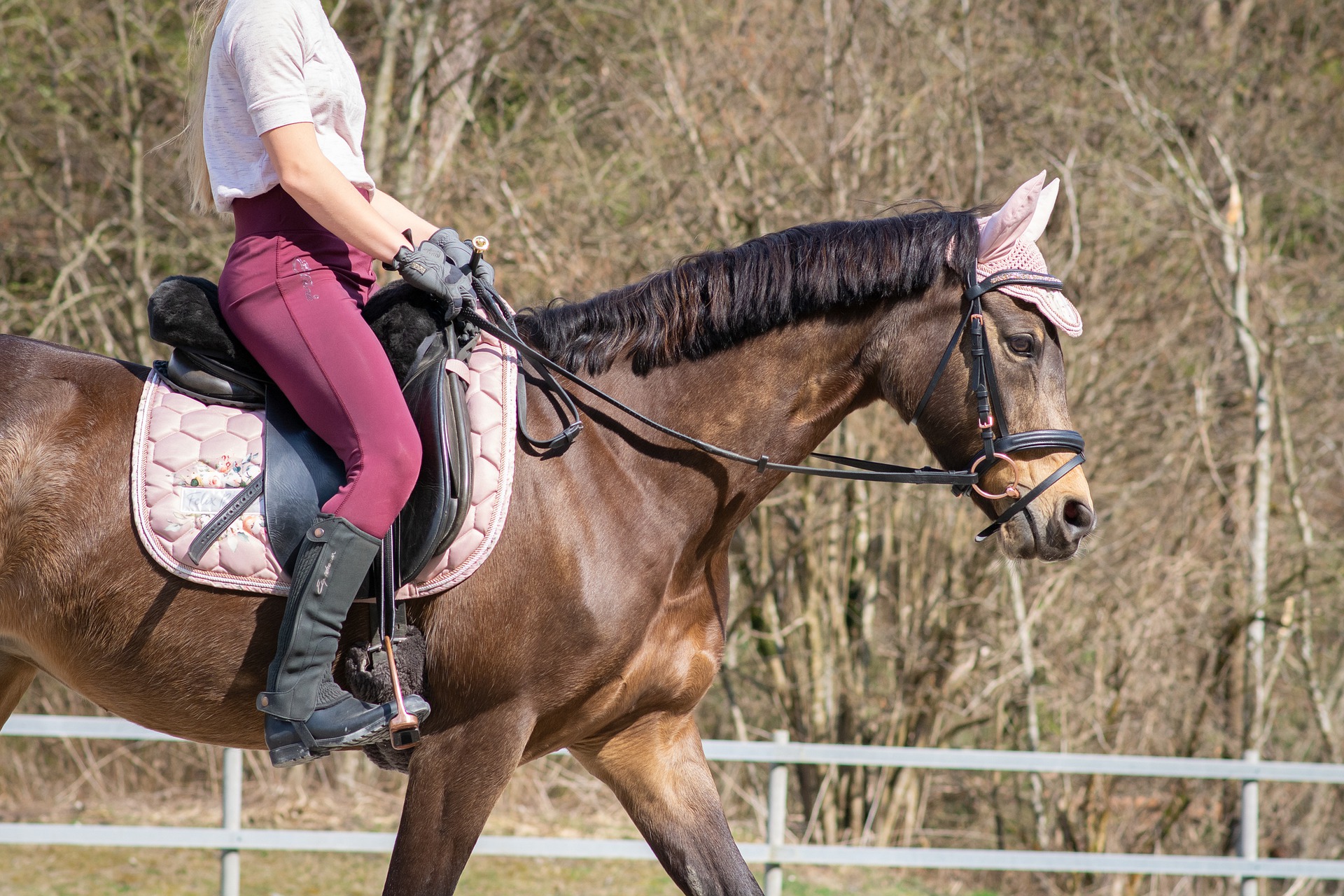When giving a riding lesson to a young girl a few days ago, I told her to take her reins so I could show her how to hold them. She responded with “what are reins?” This made me wonder if there are more people than I expected who aren’t sure what reins exactly are.
In this guide I cover:
- What reins are
- The different styles of reins
- What reins are good for certain purposes
- Fun facts and FAQs on reins
What Are Reins?
Reins are a piece of tack that attach to a bit (the mouthpiece) that the horse has in its mouth. Reins are generally just over a centimeter wide and about one third of a centimeter thick and attach to the bit on either side of the horse’s mouth. With these reins, the rider will turn, guide, and stop the horse. Using reins is a large part of communicating with the horse when you are riding or driving them.
What Are The Different Styles Of Reins?
There are so many different styles of reins that you can buy. There are reins that are designed for certain disciplines, and there are reins that are made specifically for training purposes. These are all the different styles of reins:
Split Reins
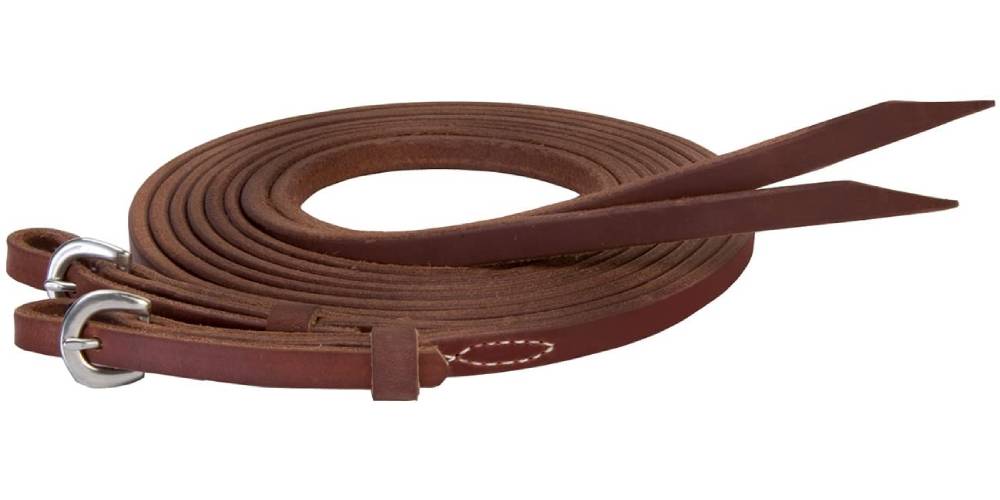
Split reins are a type of rein found only in the Western style of riding. Split reins are used in many Western riding disciplines and can be seen in Western pleasure, trail riding, general riding, reining, cutting, and more!
Split reins are generally really long and are not connected in any way. This means you have one rein for the right side and one rein for the left side.
When using split reins, make sure you are holding onto both reins! If you aren’t, you may drop one causing the horse to step on it which can cause:
- The horse to injure themselves
- The rein to break
- The bridle to break
- The horse to wrench its head up
- The horse to spook
These reins are often decorated to make them more flashy and attractive for riding in horse shows.
Barrel/Roper Reins
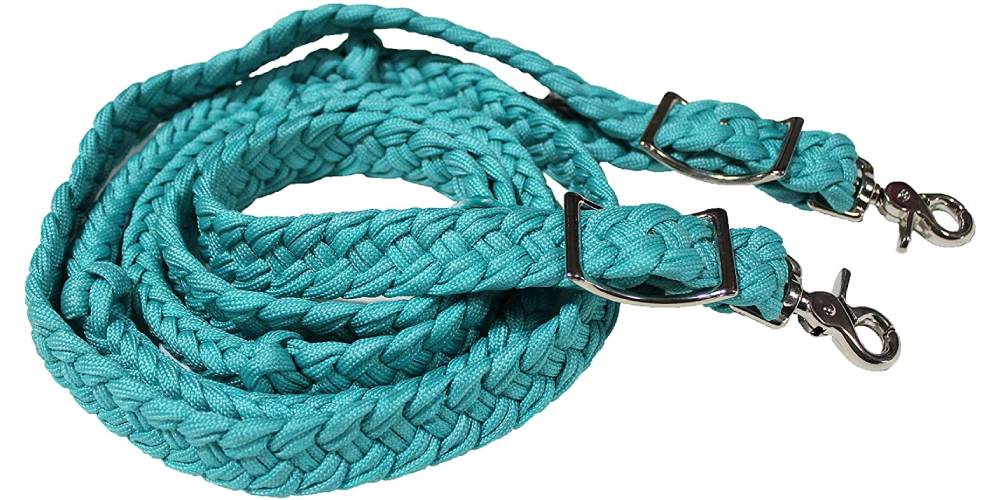
When barrel racing, it is recommended to not use split reins. Why? Because if you were to drop one rein and your horse steps on it when going full gallop, it is almost always a recipe for disaster.
Barrel reins are mainly used in western riding, specifically in the sport of barrel racing or roping. These reins are often made from a rope material similar to what lead ropes are made from. Because most barrel racers adorn their horses in flashy tack and colorful gear, these reins often come in fun bright colors.
Because of the fast turns, riders in this sport often will hold their saddle horns to help keep themselves in the saddle. This is why barrel reins can’t ever be split as often the rider doesn’t have two hands on their reins. This means that if a rein is dropped, there is a great risk that a horse will step on it.
Laced Reins
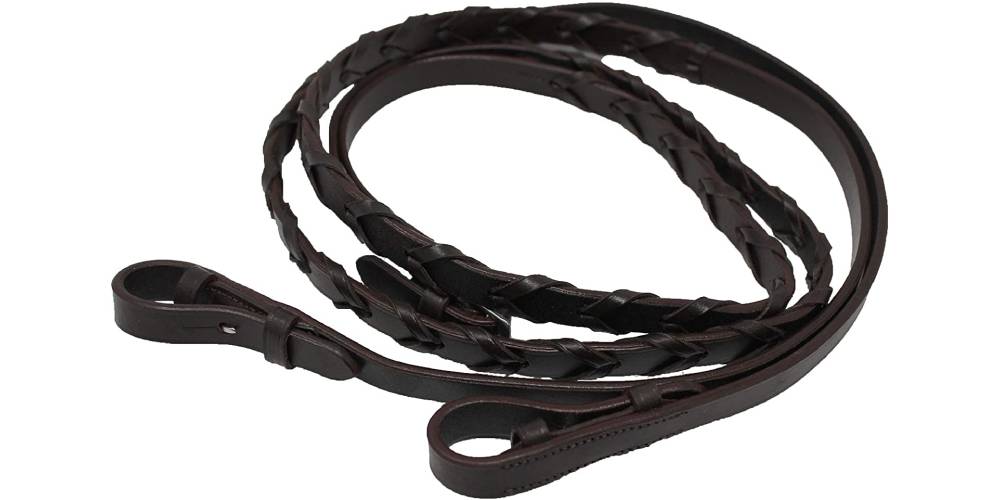
Laced reins are my favorite type of rein to ride in by far. Why? because not only do they look really cool, but they also give your hand a nice solid grip.
Laced reins are a type of rein only used in the English style of riding. The laced rein is a popular rein in a number of English riding styles. I have seen these reins used for:
- Showjumping
- Eventing
- Dressage
- Hunt Seat
- Saddle Seat
These reins are really popular with good reason. Once I started using these reins, I never have wanted to go back.
Smooth Reins
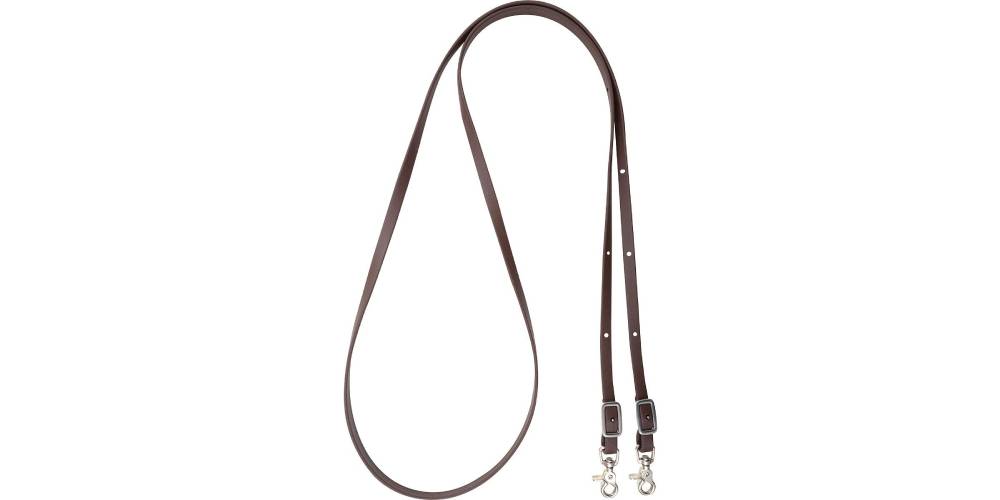
Smooth reins are just the most basic type of rein that you can buy. They just connect to either side of the bit and have no additional texture to help with gripping the reins.
Smooth reins are used in both English and Western riding. This style of rein is popular because it is simple and relatively easy to hold and use.
Rubber Grip Reins

Rubber grip reins can come in two styles.
The first style comes only in one solid color. There are sometimes little stoppers all along the rein to help grip them and the rubber covering the leather rein helps you to grip the rein as well.

The second style is the same design, but the rubber all along the rein is in different colors. This is to help riding lesson students with holding the reins evenly.
Double Reins
Double reins can be any of the types of English reins mentioned, only two sets instead of one are used. Double reins are seen in Saddle Seat riding, dressage, and English pleasure. Some jumping horses require another rein to be used as well to let the rider have more control over their mount.
Double reins are most commonly used with a Pelham bit or double bridle as these bits have more rings intended for reins.
Reins With Stoppers
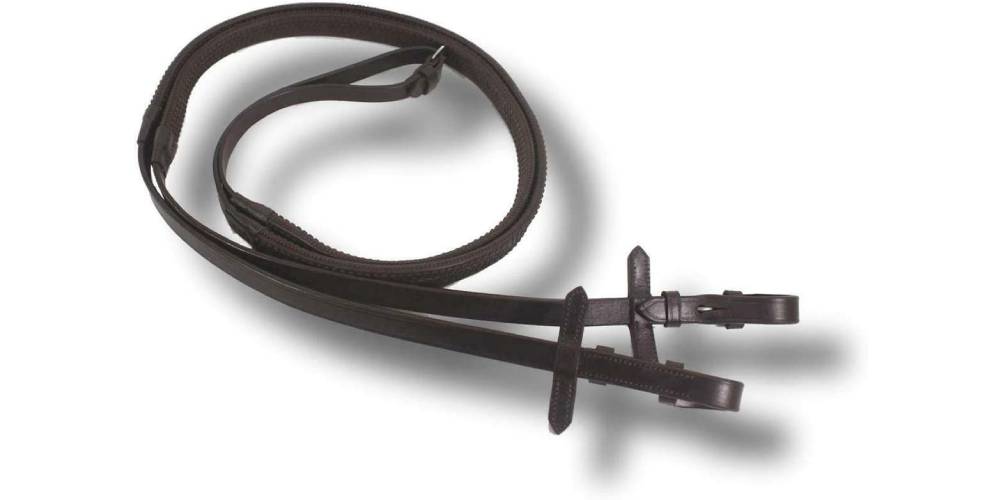
Some English reins have stoppers up near the bit that can be slid up or down depending on what is required. These stoppers are used to keep a martingale or other training device that is added to the reins from slipping over the buckle attached to the bit or stuck elsewhere near the horse’s mouth. The stoppers are just there as a safety measure to keep the martingale from trapping the horse’s head down.
Nylon Or Paracord Reins
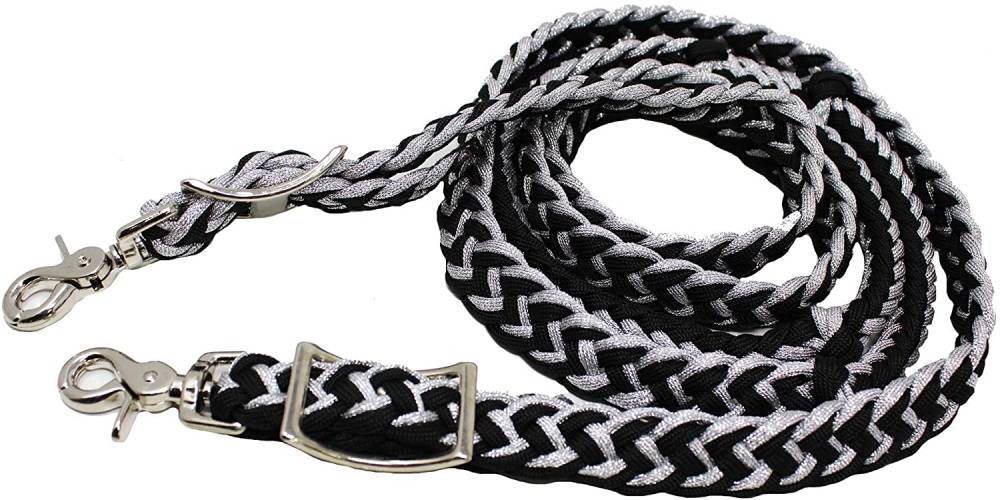
Paracord reins are reins made from woven parachute cords. These reins, because of their colorful appearance, are typically used for barrel racing or children’s riding. They are also sometimes used in other rodeo sports including pole bending, goat tying, and mounted shooting.
These reins are popular not only because of their fun and colorful appearance but also because they last a long time. Paracord reins don’t need to be conditioned and cleaned like leather reins making them a fun and low-maintenance choice for reins.
What Reins Should I Use For…
Jumping
When jumping, I recommend to use a laced rein or rubber grip reins. This is because in this sport you need to keep a good grip on your reins at all times.
These reins are really popular because they give your hand a good grip and have a professional look desired in this area of riding.
Dressage
In dressage, I recommend using double reins. These double reins I like to be laced, rubber, or smooth. The extra contact given by using that extra rein helps to keep the horse’s head in and helps with better communication with the animal.
Saddle Seat
Saddle seat is an English riding discipline that involves the use of a double bridle. A double bridle is a type of bridle that uses two bits in the horse’s mouth. One of these bits is a snaffle bit and the other bit is a special curb bit intended specifically for use with a snaffle. Because two bits are in the horse’s mouth in this style of riding, you need to use two sets of reins when riding.
The best reins to use when riding in this discipline are the laced or smooth English reins. These reins are the most common to be used in saddle seat riding.
Barrel Racing
Barrel racing is a fast paced western sport that involves quick turns around barrels and the horse traveling at really fast speeds.
The best reins to use for barrel racing are either barrel reins, nylon reins, or paracord reins. This is because you need to make sure that you are using a rein that is connected (not split) and is easy to hold and grip.
Roping
For roping, because your hands are not only being used for steering the horse, you need to make sure that you are using reins that are connected (not split) so you don’t risk dropping one of your reins.
For roping I recommend using any sort of connected reins like barrel/roper reins, nylon reins, or paracord reins. These all will work well when used for roping.
Western Pleasure
Because western pleasure is such a relaxed, low speed riding discipline, split reins are a really popular choice when it comes to selecting which reins you use. This is because these reins are really flashy and look great in western pleasure.
Reining
Reining is a fairly fast paced sport that involves spins, turns, stops, and fast gaits. Unlike most fast paced western sports however, the movements are a little more controlled and don’t require the rider to hold onto the saddle to keep themselves on. Because of this, split reins are a pretty good choice for use as they not only look flashy, but they also are still safe to use as long as you hold them with a fairly firm grip.
Riding Lessons
For riding lessons, I recommend using a type of rubber grip reins that come with the different colored rubber pieces. This is because it helps the kid taking the lesson keep their hands on the reins evenly.
Fun Facts On Reins
- Reins are first thought to be used on horses in ancient Mesopotamia
- Some reins have a price tag of over $300 (US Dollars)!
- Leather is the most common material for reins to be made of
- Some western pleasure reins have pieces of silver adorning them making the price of those specific reins insanely expensive
- Different styles of riding require that you hold the reins in different ways and positions
FAQs On Reins
How long should my reins be?
The length of the reins that you use really differ depending on the horse and the discipline and style you are riding in. Some reins are incredibly long with some split reins reaching 8 to 10 feet long per rein!
The average length for reins is around 4 to 5 feet per rein. This means that each side of the rein will measure at around 4 to 5 feet long.
For reins that are connected together and have no split in them or buckles to connect them in the middle, these reins will measure to be between 6 and 10 feet long from end to end.
How much do reins cost on average?
Your average pair of leather reins should cost you between $20 and $40 (US Dollars). Some reins, like the rope style barrel reins may cost you a little less while other reins, like the silver studded Western pleasure reins will cost you a lot more.
Reins will generally cost you between $20 and $300 (US Dollars) depending on the style, quality, and material they are made from.
How tight should I hold my reins?
You should hold your reins just tight enough to feel the contact with the horse’s mouth, but not so tight to where your horse is uncomfortable with the shortness of the reins.

